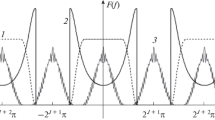Abstract
We consider the problem of forming radar images under a diffuse-target statistical model for the reflections off a target surface. The desired image is the scattering functionS(f, τ), which describes the second-order statistics of target reflectivity in delay—Doppler coordinates. Our estimation approach is obtained by application of the maximum-likelihood principle and a regularization procedure based on a wavelet representation for the logarithm ofS(f, τ). This approach offers the ability to capture significant components of lnS(f, τ) at different resolution levels and guarantees nonnegativity of the scattering function estimates. We show that the radar imaging problem can be set up as a problem of inference on the wavelet coefficients of an image corrupted by additive noise. A simple hypothesis-testing technique for solving the problem at a prespecified significance level is studied. The significance level of the test is selected according to the desired noise/resolution trade-off. The regularization technique is applicable to a broad class of speckle-noise reduction problems.
Similar content being viewed by others
References
H.L. Van Trees,Detection, Estimation, and Modulation Theory, Part III, Wiley, New York. 1971.
J. Shapiro, B.A. Capron, and R.C. Harney, “Imaging and target detection with a heterodyne-reception optical radar,”Appl. Opt., vol. 20, 1981, pp. 3292–3313.
D.L. Snyder, J.A. O'Sullivan, and M.I. Miller, “The use of maximum-likelihood estimation for forming images of diffuse radar-targets from delay—Doppler data,”IEEE Trans. Informat. Theory, vol. 35, 1989, pp. 536–548.
P. Moulin, J.A. O'Sullivan, and D.L. Snyder, “A method of sieves for multiresolution spectrum estimation and radar imaging,”IEEE Trans. Informat. Theory, vol. 38, 1992, pp. 801–813.
W. Hardle,Applied Nonparametric Regression, Cambridge University Press, New York, 1990.
P. Moulin, “Wavelet regularization techniques for power spectrum estimation and speckle noise reduction,” Bell Commun. Res., Tech. Memo., Morristown, NJ, preprint, 1992.
A.K. Jain,Fundamentals of Digital Image Processing Prentice-Hall, Englewood Cliffs, NJ, 1989.
H.H. Arsenault and G. April, “Properties of speckle integrated with a finite aperture and logarithmically transformed,”J. Opt. Soc. Am., vol. 66, 1976, pp. 1160–1163.
G. Wahba and S. Wold, “Periodic splines for spectral density estimation: The use of cross validation for determining the degree of smoothing,”Comm. Statist., 4, 1975, pp. 125–141.
H.D. Brunk, “Bayes least squares linear regression is asymptotically full Bayes: Estimation of spectral densities,” inTopics in Non-Gaussian Signal Processing Wegman, E.J., et al., eds., Springer-Verlag, Berlin, 1991, pp. 128–147.
C.L. Mallows, “Linear processes are nearly Gaussian,”J. Appl. Probab., vol. 4, 1967, pp. 313–329.
J. Rissanen,Stochastic Complexity in Statistical Inquiry World Scientific, Singapore, 1989.
H. Akaike, “A new look at the statistical model identification,”IEEE Trans. Automat. Control, vol. 19, 1974, pp. 716–723.
N.R. Goodman, “Statistical analysis based on a certain multivariate complex Gaussian distribution (an introduction),”Ann. Math. Statist., 1963, pp. 152–177.
M. Abramowitz and I.A. Stegun,Handbook of Mathematical Functions Dover, New York, 1970.
I. Daubechies,Ten Lectures on Wavelets, CBMS—NSF Regional Conference Series in Applied Mathematics Society for Industrial and Applied Mathematics, Philadelphia, 1992.
I. Daubechies, “Orthonormal bases of compactly supported wavelets,”Comm. Pure Appl. Math. vol. 41, 1988, pp. 909–996.
S.G. Mallat, “Multiresolution approximations and wavelet orthonormal bases ofL 2(R),”Trans. Amer. Math. Soc., vol. 315, 1989, pp. 69–87.
D.L. Donoho and I.M. Johnstone, “Ideal spatial adaptation by wavelet shrinkage,” Dept. of Statistics, Stanford Univ., Stanford, CA, Tech. Report, 1992.
D.R. Wehner,High Resolution Radar Artech, Norwood, MA, 1987.
S. Mallat and W.L. Hwang, “Singularity detection and processing with wavelets,”IEEE Trans. Informat. Theory vol. 38, 1992, pp. 617–643.
Author information
Authors and Affiliations
Rights and permissions
About this article
Cite this article
Moulin, P. A wavelet regularization method for diffuse radar-target imaging and speckle-noise reduction. J Math Imaging Vis 3, 123–134 (1993). https://doi.org/10.1007/BF01248407
Issue Date:
DOI: https://doi.org/10.1007/BF01248407




